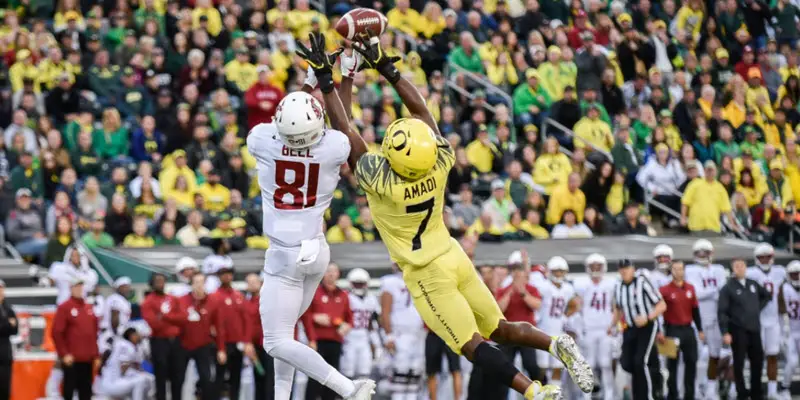Now that we have covered the general structure and defensive fronts used by Oregon defensive coordinator Jim Leavitt, we will begin delving into his coverage schemes in the next several posts. In this analysis, we will be exclusively featuring his triangle coverages: 3 defender over 2 receiver coverage concepts. (The inside “receiver” here can be either a slot receiver or a tight end.) Jim Leavitt only runs triangle coverages with two (2) deep safeties.
Leavitt’s Three Triangle Coverages
Jim Leavitt appeared to run only three triangle coverages in 2017: Quarters, Two-Read, and Halves. But he does have the ability to run any one of the three coverages to either side of the field. All three involve the cornerbacks largely in a in up close press-alignment, which can make it difficult at times for opposing quarterbacks to discern Oregon’s exact coverage at pre-snap.
Leavitt’s calls for which outside linebacker will be rushing appears to be based primarily on lining up in a field/boundary location call as opposed to a strong/weak formation. What I mean is that when the pressure is set, the pressure is set – a man in motion by the opposing offense will not change the Ducks designated rusher.
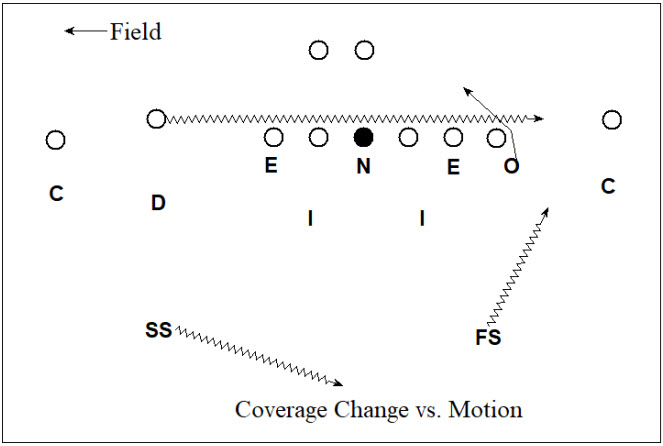
In addition, Leavitt will not push his inside linebackers out of the box to make the coverage work. So against change of strength motions, (above) the coverage will frequently change. So, for example, if the boundary outside linebacker is rushing and the offense motions to trips into the boundary, then Leavitt will simply roll into Cover 3 rather than changing the designated rusher.
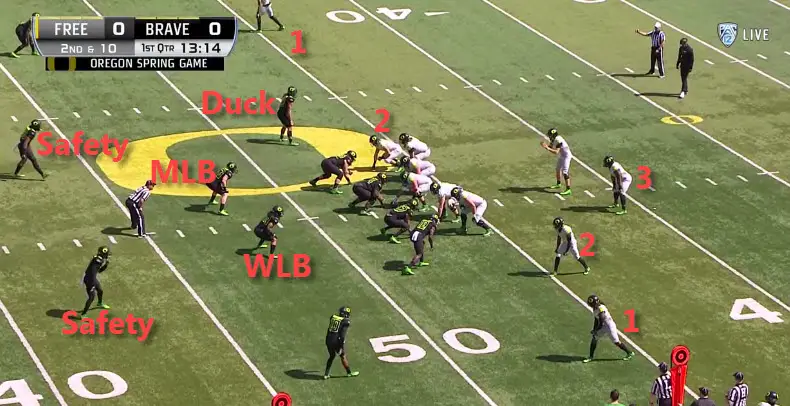
The “receiver key” numbering system for defenders.
Readers-note the numbering system of receivers by the defense above. This will be helpful as you read this and other analysis articles about coverages. The No. 1 is closest to the sideline and we count up in numbers on each side as we move closer to the center. Note the running back is considered the No. 3 receiver by the defense when counting on the right side for the defense, and the tight end is considered a No. 2 receiver when counting from the sideline inward on the left side. Charles Fischer
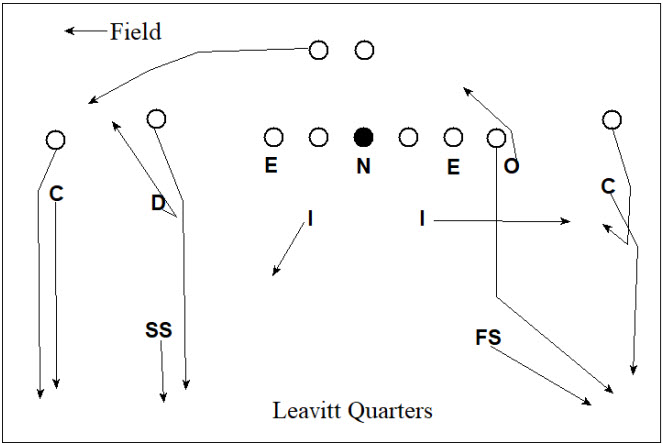
Leavitt Quarters (Triangle Coverage above)
The term “Quarters coverage” is confusingly denoted to describe both: (i) a family of related pattern match coverages that adjust who “matches” depending on the route of the No. 2 receiver, and (ii) the most commonly used form of those coverages, both in college and in the NFL. I am going to be using the latter definition in this article. “Quarters coverage” often goes by other names – some coaches might call it Sky, Nick Saban calls it Mod – but it always follows the same rules.
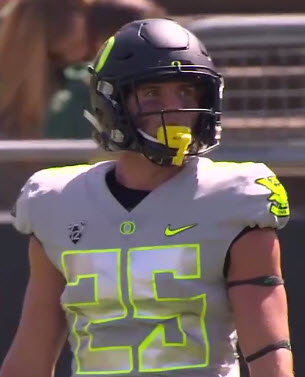
Brady Breeze is learning the safety coverages.
Corner – The corner will be in man-to-man coverage on all No. 1 receiver routes, except when No. 1 breaks at 5 yards or less (e.g., shallow, 5 yard hitch). If No. 1 breaks at 5 yards or less, the corner’s coverage is zone to deep quarter.
OLB/ILB – Takes the first man coming into the flat. E.g., No. 1 receiver if he runs a 5 yard hitch, No. 2 receiver if he runs an out or bubble route, or No. 3 if the running back swings to the flat, etc. If the No. 2 receiver begins to go vertical, always reroute No. 2 receiver before breaking to cover the first man to the flat.
Safety – Take all of No. 2 receiver vertical. If No. 2 receiver is not vertical, then bracket No.1 receiver.
ILB – Depends on the call to the opposite side:
–If Two-Read or Halves to opposite side: Take any No. 3 that will not be covered by the Corner, OLB/ILB, or Safety to that side, but in no case shall you cover anything within the first 5 yards of the line of scrimmage. Otherwise, defend the hook area deep to short.
–If Quarters to opposite side: Man defense on No. 3 receiver if he threatens to go beyond the first 5 yards of the line of scrimmage. Otherwise, defend the hook area deep to short.
Leavitt will run Quarters to both the field and to the boundary on nearly every down and distance, though it is his most common coverage to the field out of two-high.
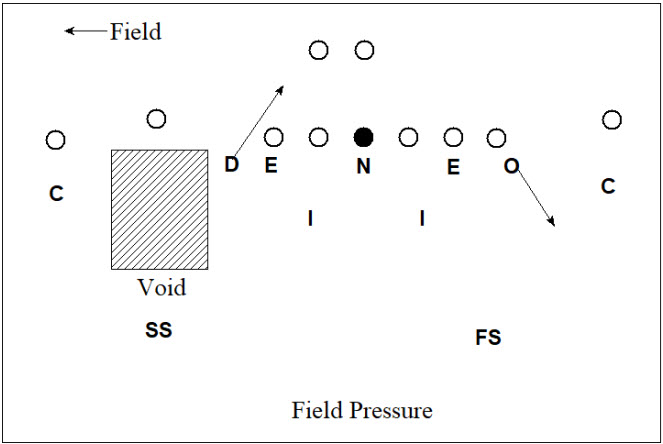
A calculated risk….
Leavitt will, on occasion, (above) appear to run Quarters to the field side even when the field outside linebacker is rushing. This frequently leaves a massive void for any short route to the No. 2 receiver wide open, though Pac-12 offenses capitalized on this gift less than I expected. Admittedly, however, when facing a wide receiver and slot receiver to the field with the field outside linebacker rushing, Leavitt more commonly ran 2-Read coverage.
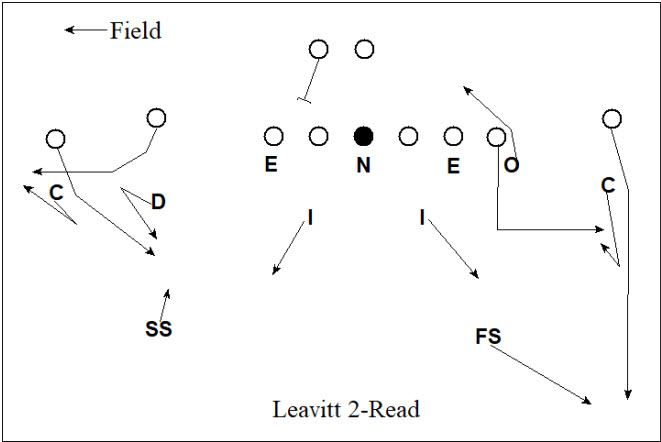
What to watch for…
Leavitt 2-Read Above (Triangle Coverage)
The 2-Read coverage follows all the same rules as Quarters coverage, except when the No. 2 receiver is out in the first 5 yards. When that happens, the corner will take the No. 2 receiver as he goes out, and the safety will cover the No. 1 receiver. If the No. 2 receiver does not go out in the first 5 yards, however, it will operate by all the same rules as Quarters.
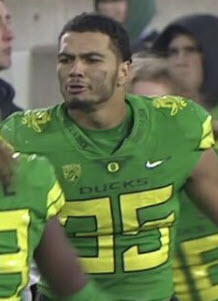
Troy Dye can cover anyone…
Corner – Align with an inside eye on No. 2 receiver. Man defense on No. 1 for everything except when:
–No. 2 receiver is out in first 5 yards, then take No. 2.
–No. 1 receiver breaks at 5 yards or less (e.g., shallow, 5 yard hitch), then take zone to deep quarter.
OLB/ILB – Man on No. 2 except when No. 2 is out in first 5 yards. Then relate to No. 3. If there is no No. 3 receiver, then defend the hook. You do not have No. 2 receiver vertical.
Safety – Take No. 1 receiver vertical if No. 2 is out in first 5 yards. Otherwise, take all of No. 2 receiver vertical. If No. 2 is not vertical, then bracket No. 1.
ILB – Take any No. 3 receiver that will not be covered by the Corner, OLB/ILB, or Safety to that side, but in no case shall you cover anything within the first 5 yards of the line of scrimmage. Otherwise, defend the hook area deep to short.
Leavitt will run 2-Read generally to the wide side of the field against a wide receiver and a slot receiver, or into the boundary against any two-man set formation. It was his preferred coverage against two-detached to the field with the field outside linebacker rushing, but beyond that, I could not discern a really clear pattern as to when he wanted to use 2-Read. (This is likely no small part, however, to the fact that 2-Read operates by all the same rules as Quarters unless the No. 2 was out short.)
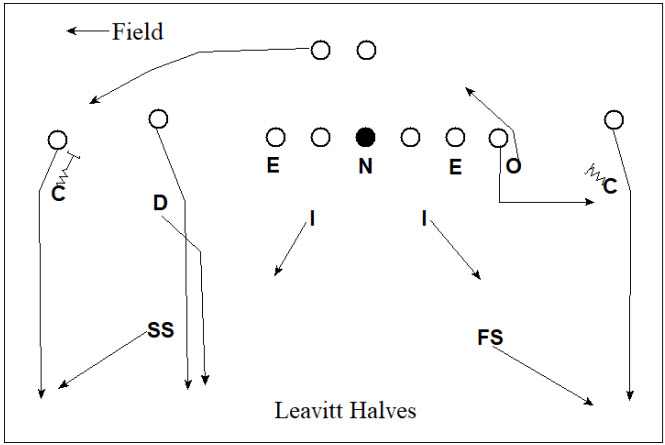
Leavitt Halves (Triangle Coverage)
“Halves coverage” is a pattern-match Cover 2 coverage. The corner will always remain down in the flat, and the safety and OLB/ILB will match up on all the routes that do not end up in the flat.
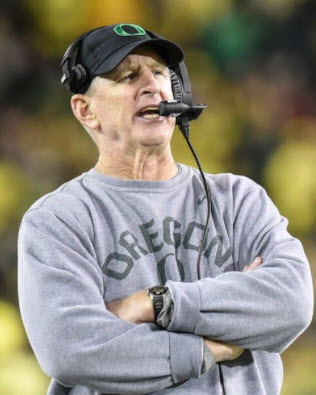
Jim Leavitt
Corner – Align with an inside eye into backfield. Take the first man to the flat. E.g., No. 1 receiver if he runs a 5 yard hitch, No. 2 if runs the out or bubble route, No. 3 if the (running back swings to the flat, etc.
OLB/ILB – If No. 3 receiver releases to your side, then man defense on No. 2 for everything. If No. 3 does not release to your side, then man on No. 2 for everything except when No. 2 receiver goes out to the flat, and then rob the No. 1 (since the safety is over the top, think interception or pass deflection).
(Rob is an assignment to undercut a route and play the ball. Go for the pick or pass deflection because there is another man playing over the top of the receiver.)
Safety – Take all of No. 1 receiver vertical. If No. 1 is not vertical, then bracket No. 2.
ILB – Take any No. 3 that will not be covered by the Corner, OLB/ILB, or Safety to that side, but in no case shall you cover anything within the first 5 yards of the line of scrimmage. Otherwise, defend the hook area deep to short.
Leavitt seems to only run Halves to the field against a tight end and flanker (and it wasn’t that often even then), but primarily into the boundary, looking to involve the corner in short-side run support. So against run-heavy offenses, Leavitt ran mostly 1-high coverage or Halves into the boundary side of the field.
So as you can see above, the Ducks have a variety of ways of covering 2 receiver sets depending on what the offense is threatening. So if the offense is running a lot of bubble routes to the field, Leavitt can 2-Read. Or if the offense is running a lot into the boundary, Leavitt can run Halves. It gives Leavitt the ability to be multiple while keeping his coverages (relatively) simple.
Cameron Soran
Hillsboro, Oregon
Top Photo by Kevin Cline
Analysis 1: Understanding the Basic Structure of the Jim Leavitt 3-4 Defense
Analysis 2: The Jim Leavitt 3-4: Oregon’s Defensive Fronts
Cameron Soran is a practicing business attorney in Hillsboro, Oregon. While not a Duck fan himself, he is an avid fan and analyst of Pac-12 (and Notre Dame) football in his spare time. He is also a contributor at https://rileykolstefootball.com/. You can follow him on Twitter @cameronsoran

